ACC2103 Managerial Accounting: Cost Analysis and Breakeven Points
VerifiedAdded on 2023/06/12
|8
|1611
|176
Homework Assignment
AI Summary
This assignment solution focuses on managerial accounting principles, specifically cost behavior and breakeven analysis. It classifies costs into fixed, variable, and mixed categories, providing detailed calculations and explanations for each. The solution includes determining the breakeven point in units and sales, and discusses the concept of margin of safety. The document also calculates total overhead cost and applied overhead cost based on machine hours. Desklib offers a wide range of academic resources, including past papers and solved assignments, to support students in their studies.
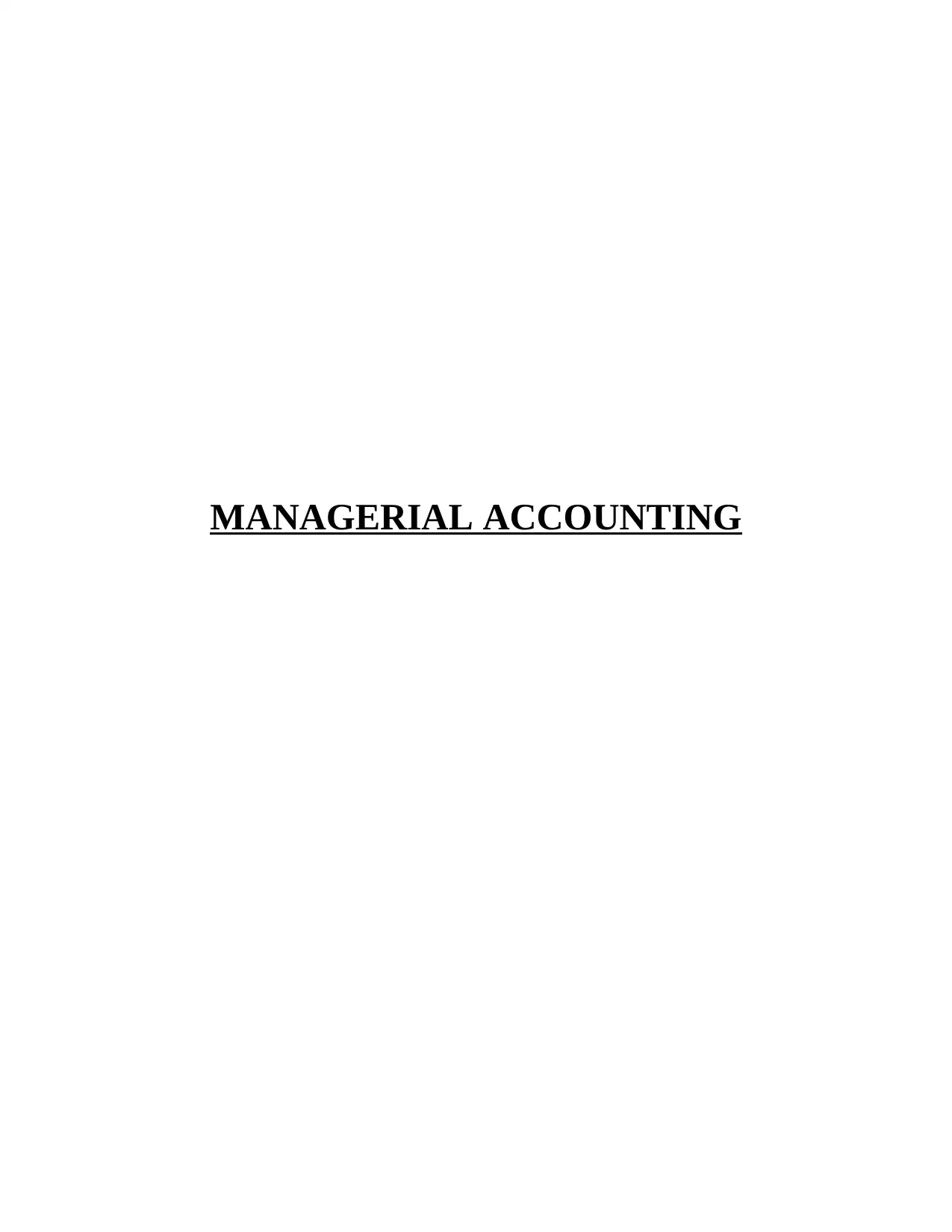
MANAGERIAL ACCOUNTING
Paraphrase This Document
Need a fresh take? Get an instant paraphrase of this document with our AI Paraphraser
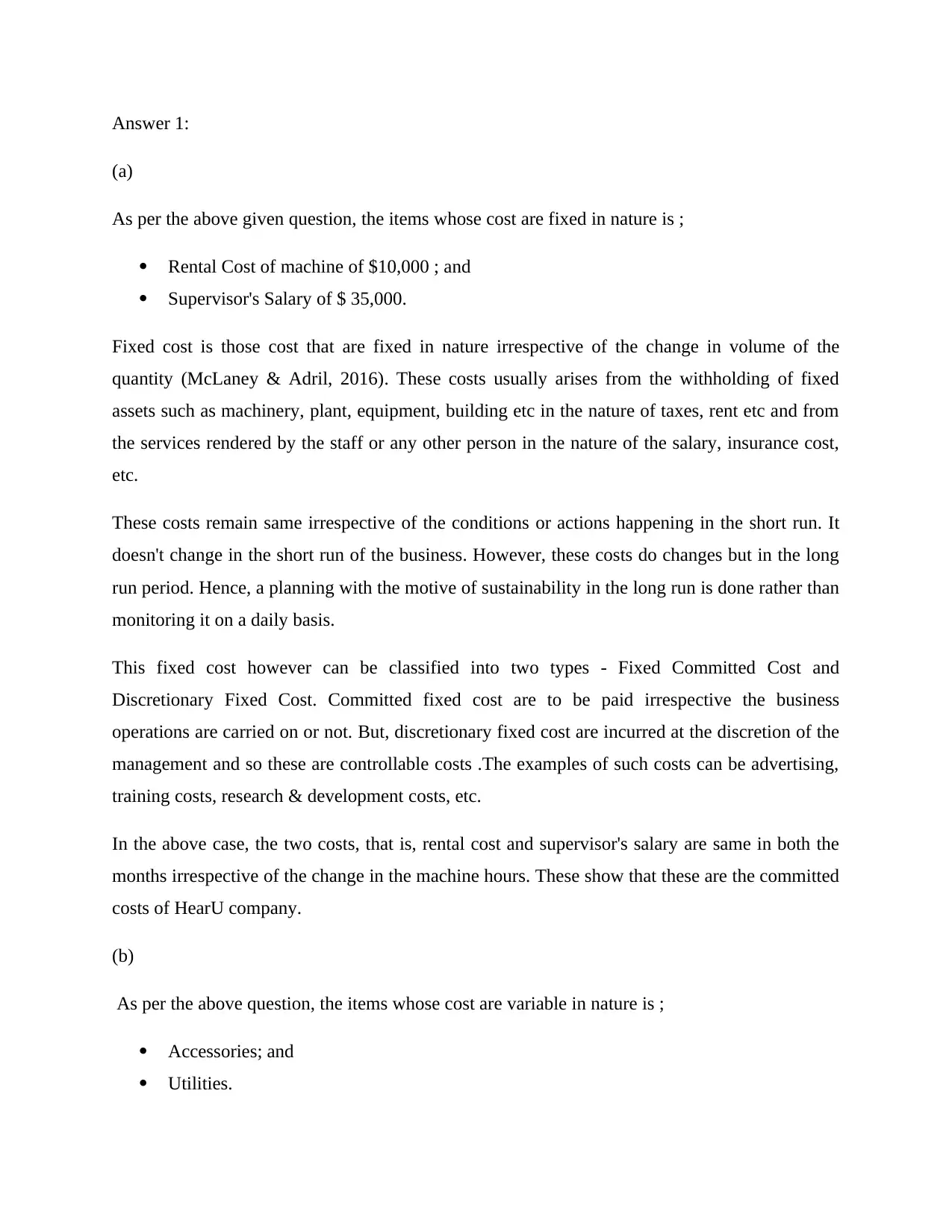
Answer 1:
(a)
As per the above given question, the items whose cost are fixed in nature is ;
Rental Cost of machine of $10,000 ; and
Supervisor's Salary of $ 35,000.
Fixed cost is those cost that are fixed in nature irrespective of the change in volume of the
quantity (McLaney & Adril, 2016). These costs usually arises from the withholding of fixed
assets such as machinery, plant, equipment, building etc in the nature of taxes, rent etc and from
the services rendered by the staff or any other person in the nature of the salary, insurance cost,
etc.
These costs remain same irrespective of the conditions or actions happening in the short run. It
doesn't change in the short run of the business. However, these costs do changes but in the long
run period. Hence, a planning with the motive of sustainability in the long run is done rather than
monitoring it on a daily basis.
This fixed cost however can be classified into two types - Fixed Committed Cost and
Discretionary Fixed Cost. Committed fixed cost are to be paid irrespective the business
operations are carried on or not. But, discretionary fixed cost are incurred at the discretion of the
management and so these are controllable costs .The examples of such costs can be advertising,
training costs, research & development costs, etc.
In the above case, the two costs, that is, rental cost and supervisor's salary are same in both the
months irrespective of the change in the machine hours. These show that these are the committed
costs of HearU company.
(b)
As per the above question, the items whose cost are variable in nature is ;
Accessories; and
Utilities.
(a)
As per the above given question, the items whose cost are fixed in nature is ;
Rental Cost of machine of $10,000 ; and
Supervisor's Salary of $ 35,000.
Fixed cost is those cost that are fixed in nature irrespective of the change in volume of the
quantity (McLaney & Adril, 2016). These costs usually arises from the withholding of fixed
assets such as machinery, plant, equipment, building etc in the nature of taxes, rent etc and from
the services rendered by the staff or any other person in the nature of the salary, insurance cost,
etc.
These costs remain same irrespective of the conditions or actions happening in the short run. It
doesn't change in the short run of the business. However, these costs do changes but in the long
run period. Hence, a planning with the motive of sustainability in the long run is done rather than
monitoring it on a daily basis.
This fixed cost however can be classified into two types - Fixed Committed Cost and
Discretionary Fixed Cost. Committed fixed cost are to be paid irrespective the business
operations are carried on or not. But, discretionary fixed cost are incurred at the discretion of the
management and so these are controllable costs .The examples of such costs can be advertising,
training costs, research & development costs, etc.
In the above case, the two costs, that is, rental cost and supervisor's salary are same in both the
months irrespective of the change in the machine hours. These show that these are the committed
costs of HearU company.
(b)
As per the above question, the items whose cost are variable in nature is ;
Accessories; and
Utilities.
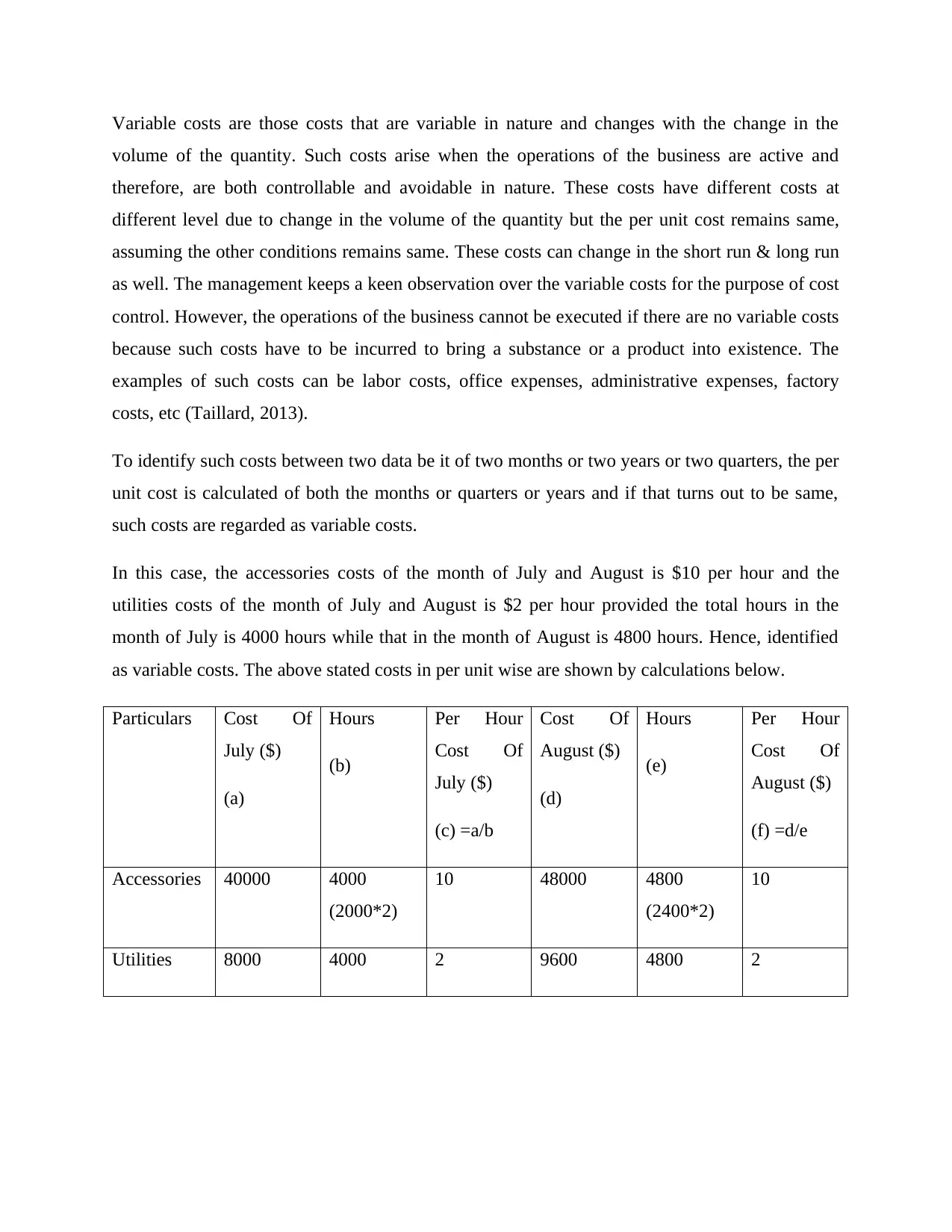
Variable costs are those costs that are variable in nature and changes with the change in the
volume of the quantity. Such costs arise when the operations of the business are active and
therefore, are both controllable and avoidable in nature. These costs have different costs at
different level due to change in the volume of the quantity but the per unit cost remains same,
assuming the other conditions remains same. These costs can change in the short run & long run
as well. The management keeps a keen observation over the variable costs for the purpose of cost
control. However, the operations of the business cannot be executed if there are no variable costs
because such costs have to be incurred to bring a substance or a product into existence. The
examples of such costs can be labor costs, office expenses, administrative expenses, factory
costs, etc (Taillard, 2013).
To identify such costs between two data be it of two months or two years or two quarters, the per
unit cost is calculated of both the months or quarters or years and if that turns out to be same,
such costs are regarded as variable costs.
In this case, the accessories costs of the month of July and August is $10 per hour and the
utilities costs of the month of July and August is $2 per hour provided the total hours in the
month of July is 4000 hours while that in the month of August is 4800 hours. Hence, identified
as variable costs. The above stated costs in per unit wise are shown by calculations below.
Particulars Cost Of
July ($)
(a)
Hours
(b)
Per Hour
Cost Of
July ($)
(c) =a/b
Cost Of
August ($)
(d)
Hours
(e)
Per Hour
Cost Of
August ($)
(f) =d/e
Accessories 40000 4000
(2000*2)
10 48000 4800
(2400*2)
10
Utilities 8000 4000 2 9600 4800 2
volume of the quantity. Such costs arise when the operations of the business are active and
therefore, are both controllable and avoidable in nature. These costs have different costs at
different level due to change in the volume of the quantity but the per unit cost remains same,
assuming the other conditions remains same. These costs can change in the short run & long run
as well. The management keeps a keen observation over the variable costs for the purpose of cost
control. However, the operations of the business cannot be executed if there are no variable costs
because such costs have to be incurred to bring a substance or a product into existence. The
examples of such costs can be labor costs, office expenses, administrative expenses, factory
costs, etc (Taillard, 2013).
To identify such costs between two data be it of two months or two years or two quarters, the per
unit cost is calculated of both the months or quarters or years and if that turns out to be same,
such costs are regarded as variable costs.
In this case, the accessories costs of the month of July and August is $10 per hour and the
utilities costs of the month of July and August is $2 per hour provided the total hours in the
month of July is 4000 hours while that in the month of August is 4800 hours. Hence, identified
as variable costs. The above stated costs in per unit wise are shown by calculations below.
Particulars Cost Of
July ($)
(a)
Hours
(b)
Per Hour
Cost Of
July ($)
(c) =a/b
Cost Of
August ($)
(d)
Hours
(e)
Per Hour
Cost Of
August ($)
(f) =d/e
Accessories 40000 4000
(2000*2)
10 48000 4800
(2400*2)
10
Utilities 8000 4000 2 9600 4800 2
⊘ This is a preview!⊘
Do you want full access?
Subscribe today to unlock all pages.

Trusted by 1+ million students worldwide
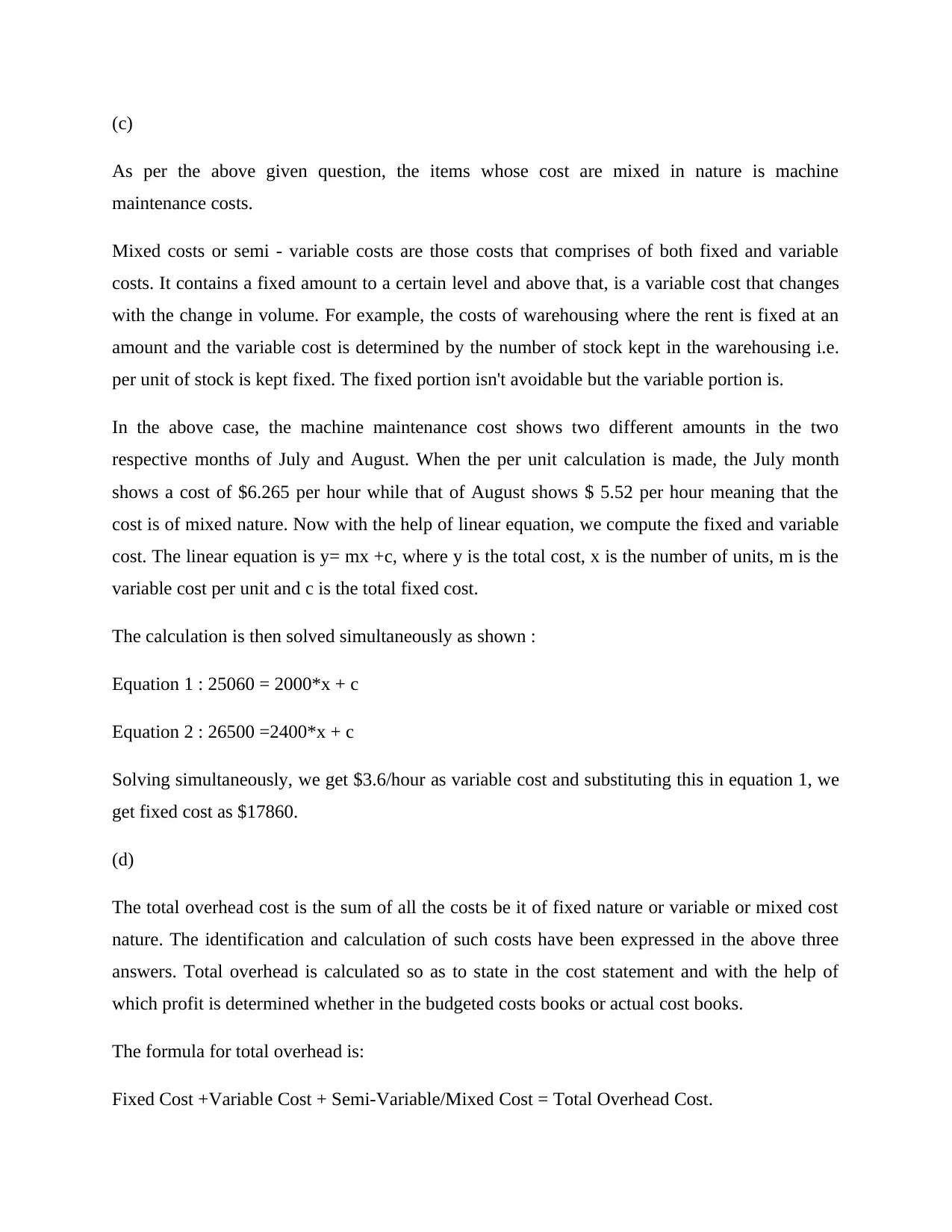
(c)
As per the above given question, the items whose cost are mixed in nature is machine
maintenance costs.
Mixed costs or semi - variable costs are those costs that comprises of both fixed and variable
costs. It contains a fixed amount to a certain level and above that, is a variable cost that changes
with the change in volume. For example, the costs of warehousing where the rent is fixed at an
amount and the variable cost is determined by the number of stock kept in the warehousing i.e.
per unit of stock is kept fixed. The fixed portion isn't avoidable but the variable portion is.
In the above case, the machine maintenance cost shows two different amounts in the two
respective months of July and August. When the per unit calculation is made, the July month
shows a cost of $6.265 per hour while that of August shows $ 5.52 per hour meaning that the
cost is of mixed nature. Now with the help of linear equation, we compute the fixed and variable
cost. The linear equation is y= mx +c, where y is the total cost, x is the number of units, m is the
variable cost per unit and c is the total fixed cost.
The calculation is then solved simultaneously as shown :
Equation 1 : 25060 = 2000*x + c
Equation 2 : 26500 =2400*x + c
Solving simultaneously, we get $3.6/hour as variable cost and substituting this in equation 1, we
get fixed cost as $17860.
(d)
The total overhead cost is the sum of all the costs be it of fixed nature or variable or mixed cost
nature. The identification and calculation of such costs have been expressed in the above three
answers. Total overhead is calculated so as to state in the cost statement and with the help of
which profit is determined whether in the budgeted costs books or actual cost books.
The formula for total overhead is:
Fixed Cost +Variable Cost + Semi-Variable/Mixed Cost = Total Overhead Cost.
As per the above given question, the items whose cost are mixed in nature is machine
maintenance costs.
Mixed costs or semi - variable costs are those costs that comprises of both fixed and variable
costs. It contains a fixed amount to a certain level and above that, is a variable cost that changes
with the change in volume. For example, the costs of warehousing where the rent is fixed at an
amount and the variable cost is determined by the number of stock kept in the warehousing i.e.
per unit of stock is kept fixed. The fixed portion isn't avoidable but the variable portion is.
In the above case, the machine maintenance cost shows two different amounts in the two
respective months of July and August. When the per unit calculation is made, the July month
shows a cost of $6.265 per hour while that of August shows $ 5.52 per hour meaning that the
cost is of mixed nature. Now with the help of linear equation, we compute the fixed and variable
cost. The linear equation is y= mx +c, where y is the total cost, x is the number of units, m is the
variable cost per unit and c is the total fixed cost.
The calculation is then solved simultaneously as shown :
Equation 1 : 25060 = 2000*x + c
Equation 2 : 26500 =2400*x + c
Solving simultaneously, we get $3.6/hour as variable cost and substituting this in equation 1, we
get fixed cost as $17860.
(d)
The total overhead cost is the sum of all the costs be it of fixed nature or variable or mixed cost
nature. The identification and calculation of such costs have been expressed in the above three
answers. Total overhead is calculated so as to state in the cost statement and with the help of
which profit is determined whether in the budgeted costs books or actual cost books.
The formula for total overhead is:
Fixed Cost +Variable Cost + Semi-Variable/Mixed Cost = Total Overhead Cost.
Paraphrase This Document
Need a fresh take? Get an instant paraphrase of this document with our AI Paraphraser
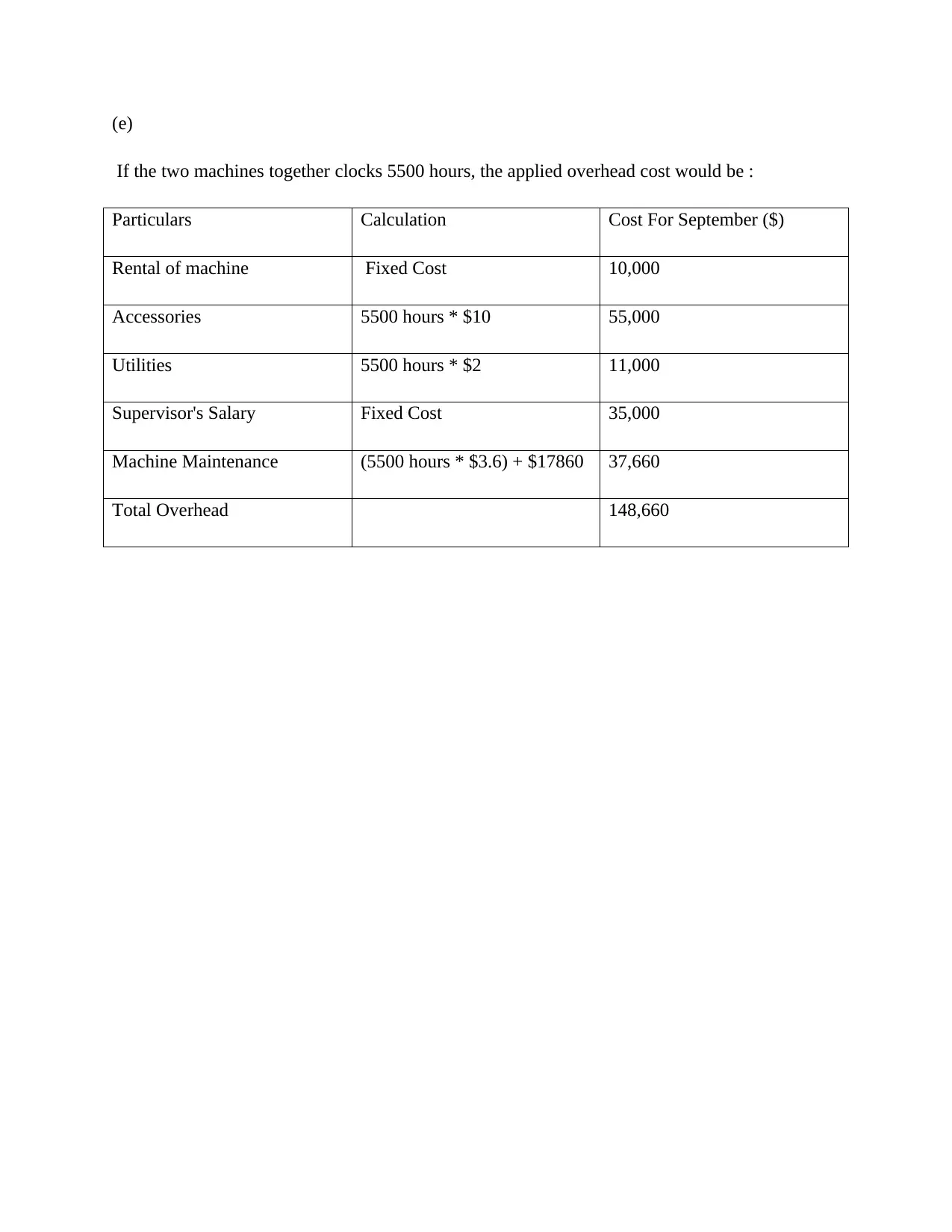
(e)
If the two machines together clocks 5500 hours, the applied overhead cost would be :
Particulars Calculation Cost For September ($)
Rental of machine Fixed Cost 10,000
Accessories 5500 hours * $10 55,000
Utilities 5500 hours * $2 11,000
Supervisor's Salary Fixed Cost 35,000
Machine Maintenance (5500 hours * $3.6) + $17860 37,660
Total Overhead 148,660
If the two machines together clocks 5500 hours, the applied overhead cost would be :
Particulars Calculation Cost For September ($)
Rental of machine Fixed Cost 10,000
Accessories 5500 hours * $10 55,000
Utilities 5500 hours * $2 11,000
Supervisor's Salary Fixed Cost 35,000
Machine Maintenance (5500 hours * $3.6) + $17860 37,660
Total Overhead 148,660
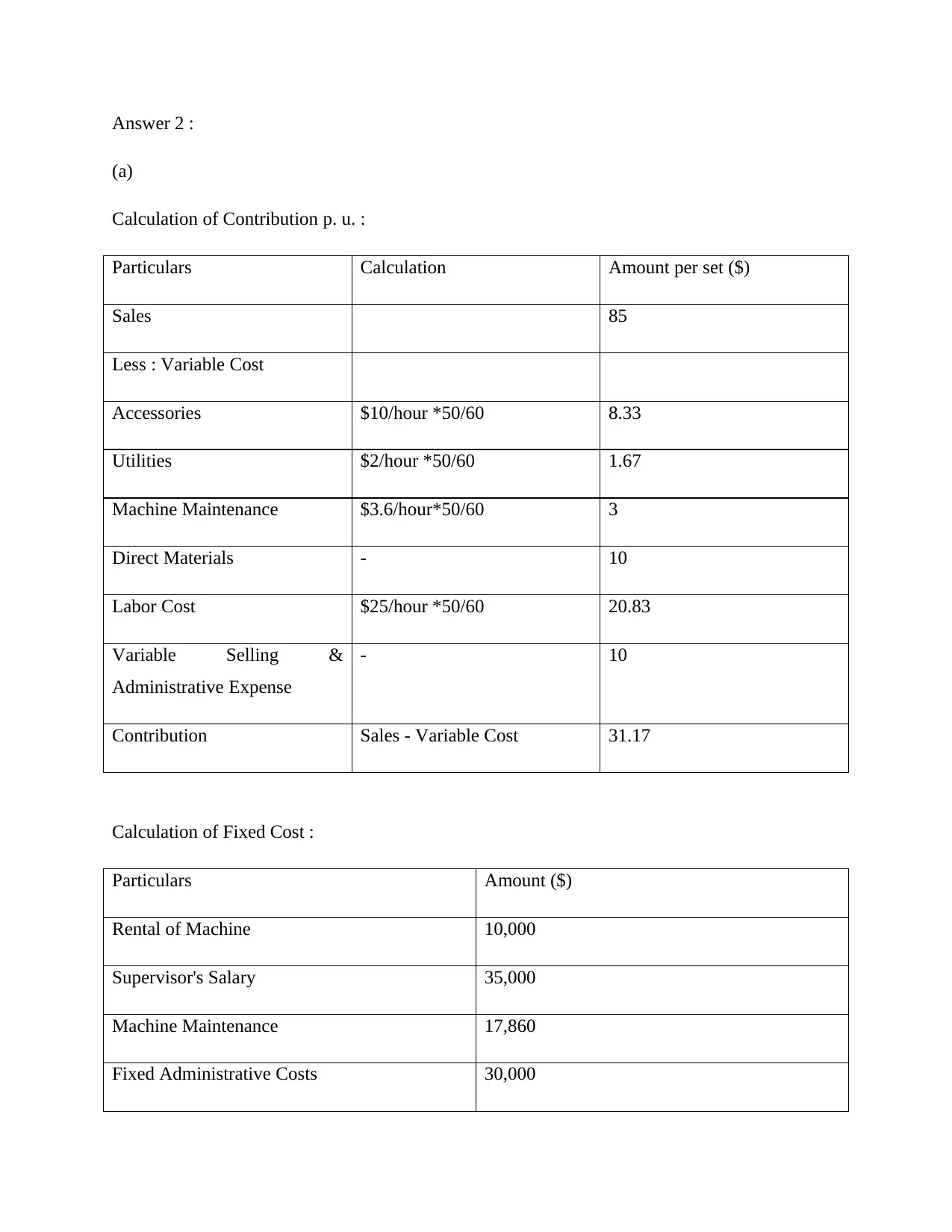
Answer 2 :
(a)
Calculation of Contribution p. u. :
Particulars Calculation Amount per set ($)
Sales 85
Less : Variable Cost
Accessories $10/hour *50/60 8.33
Utilities $2/hour *50/60 1.67
Machine Maintenance $3.6/hour*50/60 3
Direct Materials - 10
Labor Cost $25/hour *50/60 20.83
Variable Selling &
Administrative Expense
- 10
Contribution Sales - Variable Cost 31.17
Calculation of Fixed Cost :
Particulars Amount ($)
Rental of Machine 10,000
Supervisor's Salary 35,000
Machine Maintenance 17,860
Fixed Administrative Costs 30,000
(a)
Calculation of Contribution p. u. :
Particulars Calculation Amount per set ($)
Sales 85
Less : Variable Cost
Accessories $10/hour *50/60 8.33
Utilities $2/hour *50/60 1.67
Machine Maintenance $3.6/hour*50/60 3
Direct Materials - 10
Labor Cost $25/hour *50/60 20.83
Variable Selling &
Administrative Expense
- 10
Contribution Sales - Variable Cost 31.17
Calculation of Fixed Cost :
Particulars Amount ($)
Rental of Machine 10,000
Supervisor's Salary 35,000
Machine Maintenance 17,860
Fixed Administrative Costs 30,000
⊘ This is a preview!⊘
Do you want full access?
Subscribe today to unlock all pages.

Trusted by 1+ million students worldwide
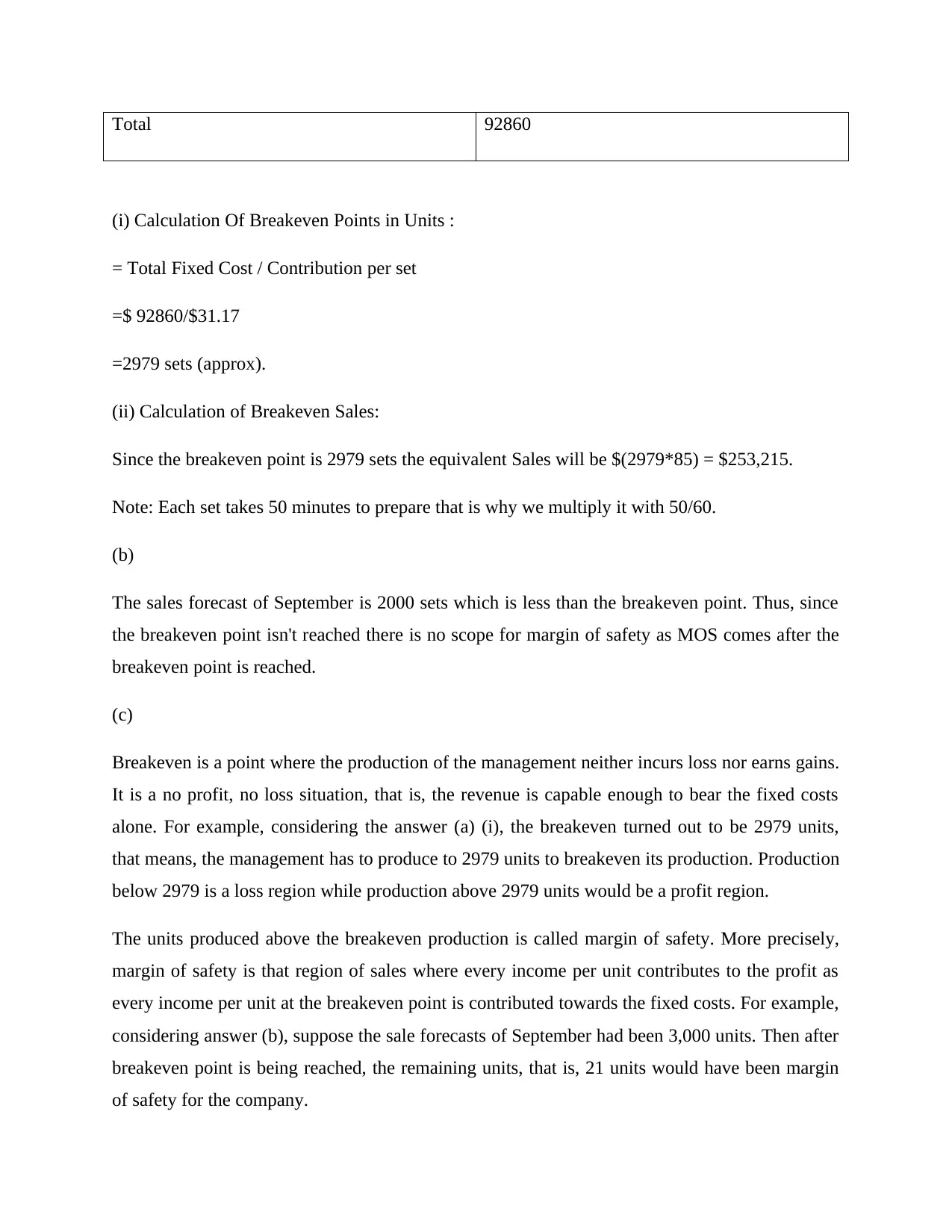
Total 92860
(i) Calculation Of Breakeven Points in Units :
= Total Fixed Cost / Contribution per set
=$ 92860/$31.17
=2979 sets (approx).
(ii) Calculation of Breakeven Sales:
Since the breakeven point is 2979 sets the equivalent Sales will be $(2979*85) = $253,215.
Note: Each set takes 50 minutes to prepare that is why we multiply it with 50/60.
(b)
The sales forecast of September is 2000 sets which is less than the breakeven point. Thus, since
the breakeven point isn't reached there is no scope for margin of safety as MOS comes after the
breakeven point is reached.
(c)
Breakeven is a point where the production of the management neither incurs loss nor earns gains.
It is a no profit, no loss situation, that is, the revenue is capable enough to bear the fixed costs
alone. For example, considering the answer (a) (i), the breakeven turned out to be 2979 units,
that means, the management has to produce to 2979 units to breakeven its production. Production
below 2979 is a loss region while production above 2979 units would be a profit region.
The units produced above the breakeven production is called margin of safety. More precisely,
margin of safety is that region of sales where every income per unit contributes to the profit as
every income per unit at the breakeven point is contributed towards the fixed costs. For example,
considering answer (b), suppose the sale forecasts of September had been 3,000 units. Then after
breakeven point is being reached, the remaining units, that is, 21 units would have been margin
of safety for the company.
(i) Calculation Of Breakeven Points in Units :
= Total Fixed Cost / Contribution per set
=$ 92860/$31.17
=2979 sets (approx).
(ii) Calculation of Breakeven Sales:
Since the breakeven point is 2979 sets the equivalent Sales will be $(2979*85) = $253,215.
Note: Each set takes 50 minutes to prepare that is why we multiply it with 50/60.
(b)
The sales forecast of September is 2000 sets which is less than the breakeven point. Thus, since
the breakeven point isn't reached there is no scope for margin of safety as MOS comes after the
breakeven point is reached.
(c)
Breakeven is a point where the production of the management neither incurs loss nor earns gains.
It is a no profit, no loss situation, that is, the revenue is capable enough to bear the fixed costs
alone. For example, considering the answer (a) (i), the breakeven turned out to be 2979 units,
that means, the management has to produce to 2979 units to breakeven its production. Production
below 2979 is a loss region while production above 2979 units would be a profit region.
The units produced above the breakeven production is called margin of safety. More precisely,
margin of safety is that region of sales where every income per unit contributes to the profit as
every income per unit at the breakeven point is contributed towards the fixed costs. For example,
considering answer (b), suppose the sale forecasts of September had been 3,000 units. Then after
breakeven point is being reached, the remaining units, that is, 21 units would have been margin
of safety for the company.
Paraphrase This Document
Need a fresh take? Get an instant paraphrase of this document with our AI Paraphraser
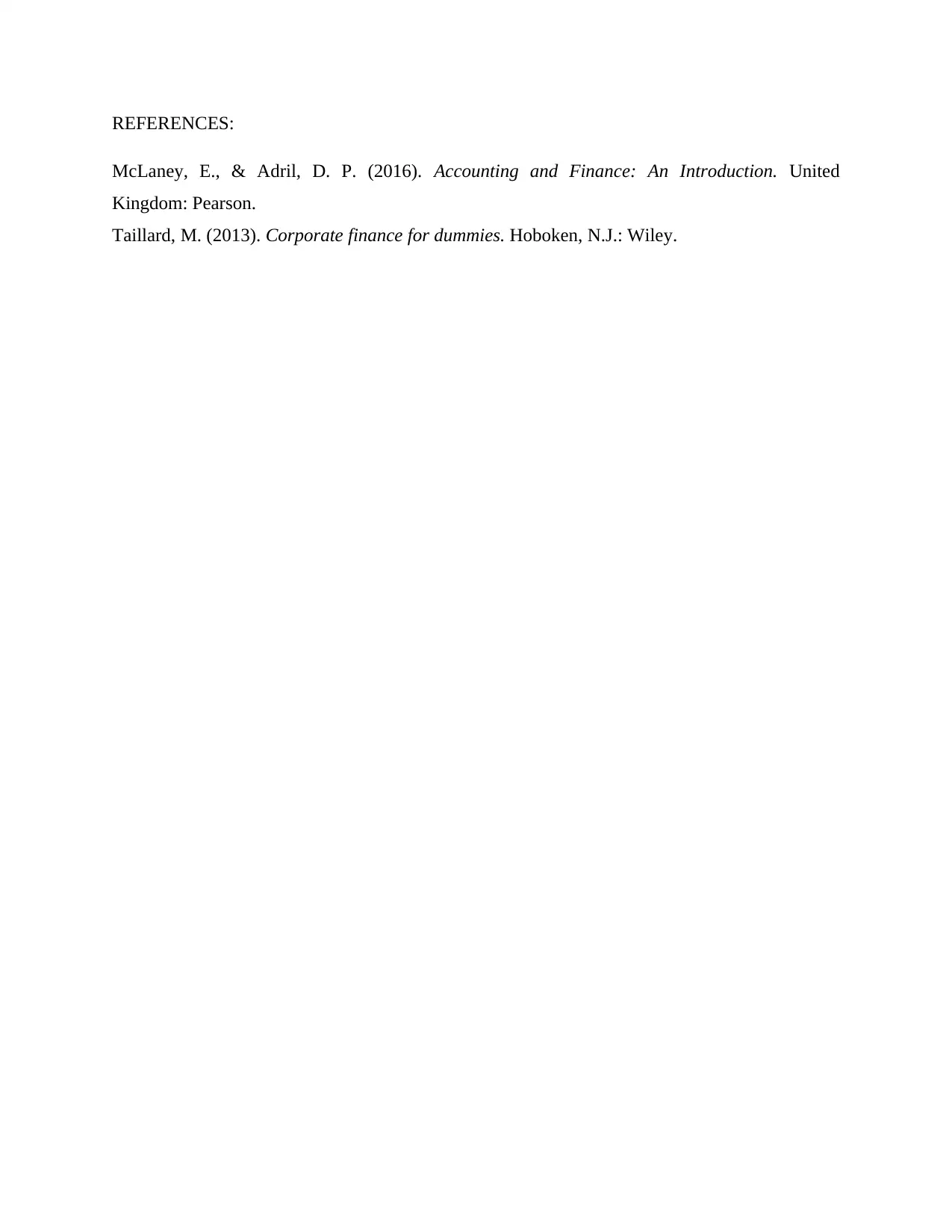
REFERENCES:
McLaney, E., & Adril, D. P. (2016). Accounting and Finance: An Introduction. United
Kingdom: Pearson.
Taillard, M. (2013). Corporate finance for dummies. Hoboken, N.J.: Wiley.
McLaney, E., & Adril, D. P. (2016). Accounting and Finance: An Introduction. United
Kingdom: Pearson.
Taillard, M. (2013). Corporate finance for dummies. Hoboken, N.J.: Wiley.
1 out of 8
Related Documents
Your All-in-One AI-Powered Toolkit for Academic Success.
+13062052269
info@desklib.com
Available 24*7 on WhatsApp / Email
![[object Object]](/_next/static/media/star-bottom.7253800d.svg)
Unlock your academic potential
Copyright © 2020–2025 A2Z Services. All Rights Reserved. Developed and managed by ZUCOL.


